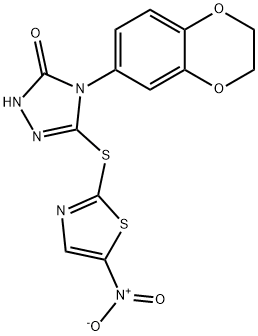Uses
BI-78D3 is an inhibitor of JNK mediated signaling. Molecular docking studies on JNK inhibitors at allosteric JNK-JIP interaction site. JNK inhibition by BI-78D3 covalent binding to JNK at Cys163 or displacement of 2-mercapto-5-nitrothiazole, or addition of BI-78D3 oxidation product. A therapeutic target of the vascular JNK pathway which improves retinal endothelial vasodilator function during early diabetes.
Definition
ChEBI: 4-(2,3-dihydro-1,4-benzodioxin-6-yl)-3-[(5-nitro-2-thiazolyl)thio]-1H-1,2,4-triazol-5-one is an aryl sulfide.
Biological Activity
bi-78d3 is a substrate competitive inhibitor of jnk inhibitor [2].jnk is a member of the mapk family. jnk is a stress-activated protein kinase that modulates pathways implicated in a variety of disease states. non-motoric jnk functions may differ between cell types and organs. the jnk is involved in a1-adrenoceptor-mediated contraction of prostate smooth muscle. for non-malignant, epithelial human prostate cells, jnk activation not only has the function of pro-apoptotic and antiproliferative but also related with jnk-dependent survival.[1]bi-78d3 is competitive with atf2 for binding to jnk1 with an apparent ki value of 200 nm. in addition, it has been reported that bi-78d3 does not inhibit the phosphorylation of a short peptide substrate lacking a d-domain. this confirms that bi-78d3 is substrate competitive.[2]bi-78d3 inhibits both noradrenaline- and phenylephrine-induced contractions. then it prevents α1-adrenoceptor-mediated contraction of prostate tissue. as an effective jnk inhibitor, bi-78d3 has the ability of abrogating cona-induced liver damage and restoring insulin sensitivity. [1,2]
References
[1] strittmatter f1, walther s, gratzke c, etal. , inhibition of adrenergic human prostate smooth muscle contraction by the inhibitors of c-jun n-terminal kinase, sp600125 and bi-78d3. br j pharmacol. 2012 jul;166(6):1926-35.
[2] stebbins jl, de sk, machleidt t,etal. , identification of a new jnk inhibitor targeting the jnk-jip interaction site. proc natl acad sci u s a. 2008 oct 28;105(43):16809-13.

